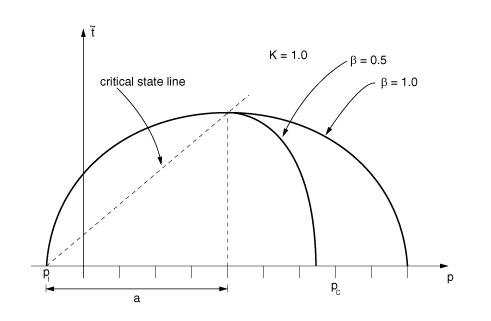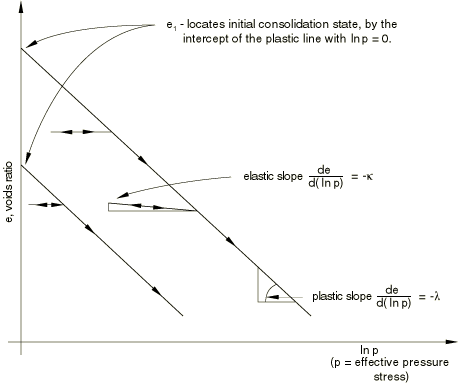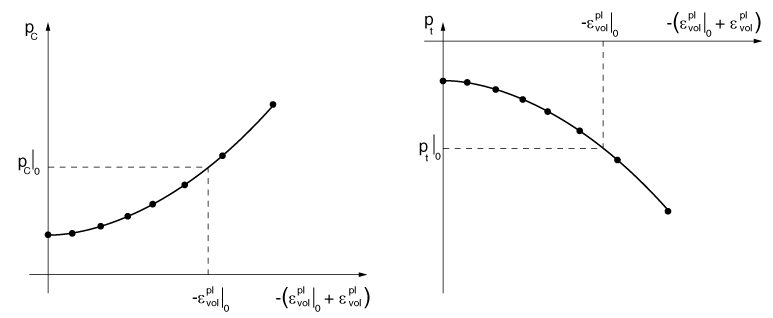Critical state (clay) plasticity model | |||||||||||||
|
| ||||||||||||
ProductsAbaqus/StandardAbaqus/ExplicitAbaqus/CAE
Yield surface
The model is based on the yield surface
where
is the equivalent pressure stress;
is the deviatoric stress measure;
is the deviatoric polar angle defined as ;
is the Hill's potential, as defined in Anisotropic yield/creep;
is the Mises equivalent stress;
is the third stress invariant;
- M
is a constant that defines the slope of the critical state line;
is a constant that is equal to 1.0 on the “dry” side of the critical state line () but may be different from 1.0 on the “wet” side of the critical state line ( introduces a different ellipse on the wet side of the critical state line; i.e., a tighter “cap” is obtained if as shown in Figure 1);
is a measure of the size of the yield surface (Figure 1);
is the yield stress in hydrostatic compression;
is the yield stress in hydrostatic tension; and
- K
is the ratio of the flow stress in triaxial tension to the flow stress in triaxial compression and determines the shape of the yield surface in the plane of principal deviatoric stresses (the “-plane”: see Figure 2); Abaqus requires that to ensure that the yield surface remains convex.
The user-defined parameters M, , and K can depend on temperature as well as other predefined field variables, . For the isotropic model, the expression for reduces to the Mises equivalent stress, . The model is described in detail in Critical state models.
Input File Usage
Use the following option to define the isotropic model:
CLAY PLASTICITY
Use the following options to define the orthotropic model:
CLAY PLASTICITY POTENTIAL
Abaqus/CAE Usage
Use the following option to define the isotropic model:
Property module: material editor: Use the following options to define the orthotropic model:
:


![]()
Hardening law
The hardening law can have an exponential form (Abaqus/Standard only) or a piecewise linear form.
Exponential form in Abaqus/Standard
The exponential form of the hardening law can be used only in conjunction with the Abaqus/Standard porous elastic material model and the isotropic form of the yield surface with . The size of the yield surface at any time is determined by the initial value of the hardening parameter, , and the amount of inelastic volume change that occurs according to the equation
where
is the inelastic volume change (that part of J, the ratio of current volume to initial volume, attributable to inelastic deformation);
is the logarithmic bulk modulus of the material defined for the porous elastic material behavior;
is the logarithmic hardening constant defined for the clay plasticity material behavior; and
is the user-defined initial void ratio (Defining initial void ratios in a porous medium).
Specifying the initial size of the yield surface directly
The initial size of the yield surface is defined for clay plasticity by specifying the hardening parameter, , as a tabular function or by defining it analytically.
can be defined along with , M, , and K, as a tabular function of temperature and other predefined field variables. However, is a function only of the initial conditions; it will not change if temperatures and field variables change during the analysis.
Input File Usage
Use all of the following options:
INITIAL CONDITIONS, TYPE=RATIO POROUS ELASTIC CLAY PLASTICITY, HARDENING=EXPONENTIAL
Abaqus/CAE Usage
Use all of the following options:
Property module: material editor: : Hardening: Exponential
Load module: Create Predefined Field: Step: Initial: choose Other for the Category and Void ratio for the Types for Selected Step
Specifying the initial size of the yield surface indirectly
The hardening parameter can be defined indirectly by specifying , which is the intercept of the virgin consolidation line with the void ratio axis in the plot of void ratio, e, versus the logarithm of the effective pressure stress, (Figure 3).

If this method is used, is defined by
where is the user-defined initial value of the equivalent hydrostatic pressure stress (see Defining initial stresses). You define , , M, , and K; all the parameters except can be dependent on temperature and other predefined field variables. However, is a function only of the initial conditions; it will not change if temperatures and field variables change during the analysis.
Input File Usage
Use all of the following options:
INITIAL CONDITIONS, TYPE=RATIO INITIAL CONDITIONS, TYPE=STRESS POROUS ELASTIC CLAY PLASTICITY, HARDENING=EXPONENTIAL, INTERCEPT=
Abaqus/CAE Usage
Use all of the following options:
Property module: material editor: : Hardening: Exponential, Intercept:
Load module: Create Predefined Field: Step: Initial: choose Other for the Category and Void ratio for the Types for Selected Step
Load module: Create Predefined Field: Step: Initial: choose Other for the Category and Stress for the Types for Selected Step
Piecewise linear form
If the piecewise linear form of the hardening rule is used, the user-defined relationship relates the yield stress in hydrostatic compression, , and, optionally, the yield stress in hydrostatic tension, , to the corresponding volumetric plastic strain, (Figure 4):

The evolution parameter, a, is then given by
The volumetric plastic strain axis has an arbitrary origin: is the position on this axis corresponding to the initial state of the material, thus defining the initial hydrostatic pressure in compression, , and, optionally, in tension, and, hence, the initial yield surface size, . This relationship is defined in tabular form as clay hardening data. The range of values for which and is defined should be sufficient to include all values of equivalent pressure stress to which the material will be subjected during the analysis. Data for must be specified; data for is optional.
This form of the hardening law can be used in conjunction with either the linear elastic or, in Abaqus/Standard, the porous elastic material models. This is the only form of the hardening law supported in Abaqus/Explicit.
Input File Usage
Use both of the following options to define the hardening behavior by providing the hydrostatic compression yield stress as a function of volumetric plastic strain:
CLAY PLASTICITY, HARDENING=TABULAR CLAY HARDENING, TYPE=COMPRESSION (default)
Optionally, add the following option to define the tensile hardening behavior by providing the hydrostatic tension yield stress as a function of volumetric plastic strain:
CLAY HARDENING, TYPE=TENSION
Abaqus/CAE Usage
Property module: material editor: : Hardening: Tabular, and/or Tensile Clay Hardening
![]()
Softening regularization
Granular materials often exhibit strain localization with increasing plastic deformation. Post-failure solutions from conventional finite element methods can be strongly mesh dependent. To mitigate the mesh dependency of the solutions, a regularization method is often used to introduce a micro-structural length scale into the constitutive formulation. Let denote the characteristic width of a shear band or a crack band, the characteristic length of the element, and the inelastic strain for the element. Then the inelastic strain in the localization band, , is defined to be
where is a material parameter and is a positive number used for bounding the magnitude of regularization. This strain regularization method is valid only when the characteristic length of the element is greater than the width of the localization band; i.e., .
If softening regularization is included, it is applied to all hardening data (tension and compression) by default. You can optionally turn off softening regularization for a specific type of hardening.
Input File Usage
Use the following options to include softening regularization:
CLAY PLASTICITY CLAY HARDENING, SR=ON (default) SOFTENING REGULARIZATION
Use the following option to turn off softening regularization:
CLAY HARDENING, SR=OFF
Abaqus/CAE Usage
Use the following options to include softening regularization:
Property module: material editor: :
![]()
Calibration
At least two experiments are required to calibrate the simplest version of the Cam-clay model: a hydrostatic compression test (an oedometer test is also acceptable) and a triaxial compression test (more than one triaxial test is useful for a more accurate calibration).
Hydrostatic compression tests
The hydrostatic compression test is performed by pressurizing the sample equally in all directions. The applied pressure and the volume change are recorded.
The onset of yielding in the hydrostatic compression test immediately provides the initial position of the yield surface, . The logarithmic bulk moduli, and , are determined from the hydrostatic compression experimental data by plotting the logarithm of pressure versus void ratio. The void ratio, e, is related to the measured volume change as
The slope of the line obtained for the elastic regime is , and the slope in the inelastic range is . For a valid model .
Triaxial tests
Triaxial compression experiments are performed using a standard triaxial machine where a fixed confining pressure is maintained while the differential stress is applied. Several tests covering the range of confining pressures of interest are usually performed. Again, the stress and strain in the direction of loading are recorded, together with the lateral strain so that the correct volume changes can be calibrated.
The triaxial compression tests allow the calibration of the yield parameters M and . M is the ratio of the shear stress, q, to the pressure stress, p, at critical state and can be obtained from the stress values when the material has become perfectly plastic (critical state). represents the curvature of the cap part of the yield surface and can be calibrated from a number of triaxial tests at high confining pressures (on the “wet” side of critical state). must be between 0.0 and 1.0.
To calibrate the parameter K, which controls the yield dependence on the third stress invariant, experimental results obtained from a true triaxial (cubical) test are necessary. These results are generally not available, and you may have to guess (the value of K is generally between 0.8 and 1.0) or ignore this effect.
To calculate the yield stress in hydrostatic tension, you can plot the data obtained from the triaxial compression tests on the – plane and extend the curve obtained from fitting these experimental data to the pressure axis in the tensile region.
Unloading measurements
Unloading measurements in hydrostatic and triaxial compression tests are useful to calibrate the elasticity, particularly in cases where the initial elastic region is not well defined. From these we can identify whether a constant shear modulus or a constant Poisson's ratio should be used and what their values are.
![]()
Initial conditions
If an initial stress at a point is given (see Defining initial stresses) such that the stress point lies outside the initially defined yield surface, Abaqus will try to adjust the initial position of the surface to make the stress point lie on it and issue a warning. However, if the yield stress in hydrostatic tension, , is zero and does not evolve with volumetric plastic strain and the stress point is such that the equivalent pressure stress, p, is negative, an error message will be issued and execution will be terminated.
The initial condition on volumetric plastic strain, , can be defined in the definition of the clay plasticity model. Abaqus also allows a general method of specifying the initial plastic strain field on elements (see Defining initial values of plastic strain). The volumetric plastic strain is then calculated as
![]()
Elements
The clay plasticity model can be used with plane strain, generalized plane strain, axisymmetric, and three-dimensional solid (continuum) elements in Abaqus. This model cannot be used with elements for which the assumed stress state is plane stress (plane stress, shell, and membrane elements).
![]()
Output
In addition to the standard output identifiers available in Abaqus (Abaqus/Standard output variable identifiers and Abaqus/Explicit output variable identifiers), the following variable has special meaning for material points in the clay plasticity model:
- PEEQ
Center of the yield surface, a.